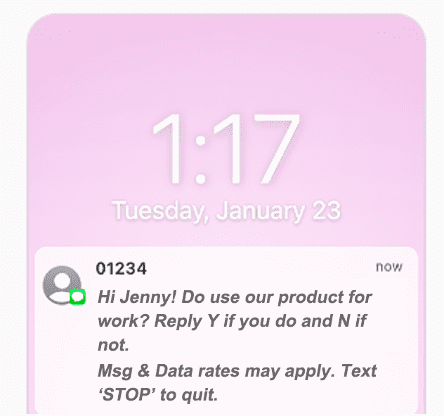Modern, data-driven marketing hinges on the ability to deliver highly targeted and personalized messages to specific customer segments. Many organizations aim to send tailored offers, valuable tips, or personalized content to customers who fit specific criteria.
However, marketing teams frequently face a frustrating roadblock: they lack the necessary data to accurately identify these cohorts. This leaves them with the difficult choice of sending a broad campaign that risks alienating customers who don’t fit this criteria or skipping the campaign altogether.
Though instrumenting the capture and storage of quantitative data can solve some of these problems, executing such instrumentation is no easy, or short-term task. Additionally, qualitative data can often have gaps that prevent the true targeting and segmentation that marketers need.
Given these limitations, what steps can marketers take to fill these gaps and create truly personalized marketing experiences?
The Limitations of Quantitative Data


Quantitative data—such as purchase history, website behavior, and demographic details—has long been the backbone of customer profiling. It provides valuable insights into “what” customers are doing but often fails to answer the crucial “why.”
For example, while data might show that a customer purchased a particular product, it doesn’t reveal their motivations, preferences, or how they felt about the experience. This lack of context can lead to broad, generic segmentation and impersonal messaging that doesn’t fully resonate.
Moreover, capturing and managing quantitative data requires significant engineering resources to build and maintain. Marketing teams often depend on these resources to implement data tracking across platforms.
However, engineering teams are frequently booked out for long periods with high-priority operational tasks, causing marketing requests to be deprioritized. This can delay or even prevent the data instrumentation needed for more precise targeting.
Quantitative data alone can leave gaps when it comes to personalization, as it often lacks the depth needed to understand customer motivations and adapt quickly to their needs. To truly connect with and engage customers, marketers should enhance their data strategies with qualitative insights that provide a more complete picture.
The Power of Qualitative Data


Qualitative data provides valuable insights that quantitative data alone cannot offer. It uncovers deeper customer experiences, revealing specific pain points, desires, and preferences that help refine marketing strategies.
One major advantage is its ability to identify emerging trends and customer sentiments not yet captured by numerical data. For instance, customer feedback might highlight new product needs or feature requests, guiding future innovations.
Qualitative data also enriches customer personas by adding context beyond demographics. This deeper understanding allows for more precise segmentation and personalized messaging that resonates more effectively with target audiences.
Additionally, continuous qualitative feedback supports ongoing campaign improvements. It helps marketers adjust strategies in real-time based on customer reactions, ensuring content remains relevant and engaging.
By integrating qualitative insights, marketers can complement quantitative data to create more impactful and personalized marketing strategies, fostering stronger customer relationships and enhancing overall campaign success.
The Challenges of Collecting Qualitative Data
While qualitative data offers profound insights and enhances marketing strategies, collecting it comes with its own set of challenges. One major issue is the cost and effort involved. Methods, such as in-depth interviews, focus groups, and long-form surveys, can require significant resources, including hiring specialized personnel or agencies and managing complex logistics, leading to higher expenses and extended timelines.
Additionally, long-form surveys, while valuable for gathering comprehensive insights, often suffer from low response rates and can be quite off-putting for customers. Participants may find lengthy surveys tedious or time-consuming, leading to incomplete or unreliable data. This can skew results and make it harder to draw accurate conclusions from the collected information. Additionally, open-text questions in qualitative data can introduce subjectivity and variability in responses, requiring skilled analysts to carefully interpret and extract meaningful insights.
Ensuring the quality and representativeness of qualitative data also poses a challenge. Also, small sample sizes may not capture the full diversity of the customer base, limiting the generalizability of the findings and affecting the overall effectiveness of marketing strategies.
Short-Form Surveys—A Marketer’s Secret Weapon
In the quest for richer customer insights, short-form surveys have emerged as a powerful yet often underutilized tool. These brief, one or two-question surveys can be seamlessly integrated into various touchpoints throughout the customer journey, offering marketers a quick and effective way to gather valuable qualitative data at scale.
One of the key advantages of short-form surveys is their ability to collect targeted data without overwhelming customers or adding friction to the customer journey. To effectively capitalize on this effective tactic, marketers can leverage simple, multiple-choice questions integrated into channels, such as push notifications, in-app messages, or SMS surveys.
These three quick and easy formats encourage higher engagement rates and provide valuable data that can be used to refine customer profiles and drive personalized marketing strategies.


Note-taking app Evernote asks users about their habits via mobile push.
1. Push Notifications
Push notifications are a highly effective way to engage users directly on their mobile devices. By incorporating a single, multiple-choice question into a push notification, marketers can capture immediate feedback without requiring much effort from the user.
For example, a push notification might ask, “Which type of product update are you most interested in?” with options like “New Features,” “Special Discounts,” or “User Tips.” Users can simply tap on their preferred option, and their response is instantly recorded and updated in their customer profile.
2. In-App Messages
In-app messages provide another great opportunity to gather customer insights without disrupting the user experience. These messages can be designed to appear at strategic points, such as after a customer completes a purchase or reaches a certain milestone within an app.
For example, an in-app message could ask, “Which type of content would you find most helpful in our app?” with options like “How-to Guides,” “Video Tutorials,” or “Customer Stories.” Users can respond with a single tap, providing valuable feedback that helps tailor content and features to better meet their needs.
3. SMS Surveys
SMS offers a direct and personal channel to reach customers, and a well-crafted SMS survey can effectively capture insights with minimal friction. While SMS does not support interactive elements like buttons, it can include a single link to a very simple, one or two-question poll.
For instance, a message might say, “Help us improve your experience! Which feature would you like to see next in our app? Click here to choose: [link].” The link would take users to a mobile-friendly page where they can select an option with a single click. This streamlined approach minimizes effort and maximizes response rates.


SMS surveys can turn an easy yes-no question into valuable insights.
By strategically incorporating these simple, multiple-choice questions into different customer touchpoints, marketers can efficiently gather targeted qualitative data. This approach not only enriches customer profiles with minimal customer effort but also provides the necessary insights to drive more personalized and effective marketing campaigns.
Analyzing and Leveraging Qualitative Data
While collecting qualitative data through short-form surveys is a serious upgrade to your cross-channel marketing strategy, it’s just the beginning. To truly capitalize on these insights, marketers must carefully analyze the data and leverage it to refine their targeting and segmentation strategies.
Leverage Insights for Targeting and Segmentation
Use the identified themes to create targeted campaigns. For example, if customers express a preference for eco-friendly products, a retailer can develop campaigns featuring sustainable items, such as recycled-material home goods. This tailored approach ensures the messaging resonates with the target audience.
Combine Qualitative and Quantitative Data
Integrate qualitative insights with quantitative data for enhanced targeting. For example, if quantitative data shows high repeat purchases for organic cotton bed sheets, and qualitative feedback indicates a preference for ethically sourced products, a retailer can target these customers with related products, like bamboo towels.
Continuously Optimize
Regularly update your customer segments and marketing strategies based on ongoing survey data. By continuously collecting and applying insights, you can stay aligned with evolving customer preferences and trends, making your marketing efforts more dynamic and responsive.
Key Considerations for Collecting and Leveraging Qualitative Data
To effectively capture, store, and utilize qualitative data, organizations must ensure they have the right people, processes, and tools in place.
First, having skilled personnel who understand both the technical and strategic aspects of data management is crucial. These people might be in-house marketing operations professionals or strategic consulting partners who can provide guidance and insights for leveraging this data.
Second, implementing streamlined processes for data capture and integration is essential. This involves setting up efficient workflows for collecting data through short-form surveys or other methods, ensuring it is properly stored, and integrating it seamlessly into your cross-channel marketing platforms.
Utilizing advanced tools, such as data warehouses and data management platforms can streamline this work, enabling easy access to actionable insights for targeted marketing efforts.
By aligning the right people, processes, and tools, organizations can optimize their qualitative data efforts, leading to more informed decision-making and enhanced marketing strategies.
Achieve the Best of Both Worlds
Leveraging both quantitative and qualitative data is crucial for crafting highly personalized and effective marketing strategies. While quantitative data provides a solid foundation, integrating qualitative insights through tools like short-form surveys can offer a deeper understanding of customer preferences and behaviors, enabling enhanced targeting and segmentation.
Embracing these practices enables marketers to move beyond generic campaigns and deliver truly relevant and engaging experiences.
To learn more about Iterable’s qualitative and quantitative data activation capabilities, schedule a demo today.

































